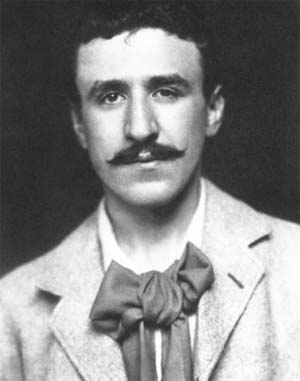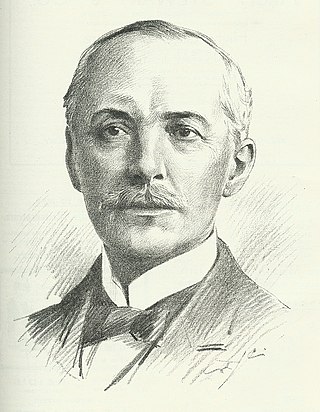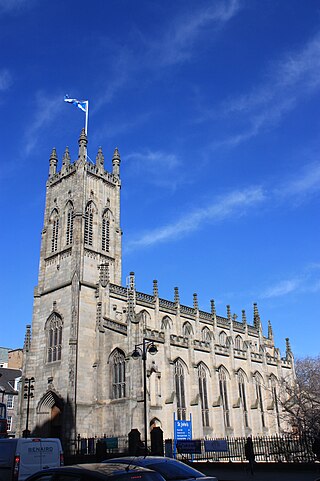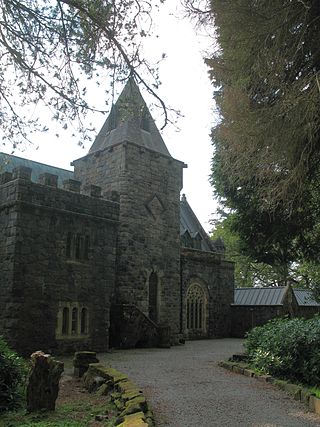
Charles Rennie Mackintosh was a Scottish architect, designer, water colourist and artist. His artistic approach had much in common with European Symbolism. His work, alongside that of his wife Margaret Macdonald, was influential on European design movements such as Art Nouveau and Secessionism and praised by great modernists such as Josef Hoffmann. Mackintosh was born in Glasgow, Scotland and died in London, England. He is among the most important figures of Modern Style.
The Scottish Episcopal Church is a Christian denomination in Scotland. Scotland's third largest church, the Scottish Episcopal Church has 303 local congregations. It is also an ecclesiastical province of the Anglican Communion.
Garnethill is a predominantly residential area of the city of Glasgow, Scotland with a number of important public buildings.

James Gillespie Graham was a Scottish architect, prominent in the early 19th century.
The Free Church of Scotland is a conservative evangelical Calvinist denomination in Scotland. It is the continuation of the original Free Church of Scotland that remained outside the union with the United Presbyterian Church of Scotland in 1900, and remains a distinct Presbyterian denomination in Scotland.

Queen's Cross Church is a former Church of Scotland parish church in Glasgow, Scotland. It is the only church designed by Charles Rennie Mackintosh to have been built; hence, it is also known as The Mackintosh Church.
Blythswood Hill, crowned by Blythswood Square, is an area of central Glasgow, Scotland. Its grid of streets extend from the length of the west side of Buchanan Street to Gordon Street and Bothwell Street, and to Charing Cross, Sauchiehall Street and Garnethill. Developed from 1800 onwards, its Georgian and Victorian architecture is a Conservation Area. It started as the "Magnificent New Town of Blythswood", becoming a part of the city-centre's business and social life.
The Snell Exhibition is an annual scholarship awarded to students of the University of Glasgow to allow them to undertake postgraduate study at Balliol College, Oxford. The award was founded by the bequest of Sir John Snell in a will made in 1677, although the original stipulation referred to the University of Oxford, rather than Balliol in particular. Snell died on 6 August 1679, but wrangling over the will meant that it was nearly twenty years before the first scholarships were awarded; the first four Snell Exhibitioners were admitted to Balliol in mid-1699.

Sir John James Burnet was a Scottish Edwardian architect who was noted for a number of prominent buildings in Glasgow and London. He was the son of the architect John Burnet, and later went into partnership with his father, joining an architectural firm which would become an influential force in British Modern architecture in the 20th century.

Baron Blythswood, of Blythswood in the County of Renfrew, was a title in the Peerage of the United Kingdom. It was created on 24 August 1892 for Sir Archibald Campbell, 1st Baronet, the former Member of Parliament for Renfrew, with remainder failing heirs male of his own to five of his younger brothers and the heirs male of their bodies.

Innis Chonain or Innischonan is an island in Loch Awe, Scotland connected to the mainland by a bridge.

The Church of St John the Evangelist is a Scottish Episcopal church in the centre of Edinburgh, Scotland. It is sited at the west end of Princes Street at its junction with Lothian Road, and is protected as a category A listed building.

Glasgow Art Club is a club in Glasgow for artists and non-artists interested in creating art and the enjoyment of art - all illustrative arts, sculptures, poetry, prose, plays, music, song, choreography and dance. To advance, promote and encourage the arts in all forms. It has ranges of exhibitions, events and concerts, open to the public for their enjoyment; and, subject to club events, a number of its rooms are available as venues for social occasions.

St Conan's Kirk is located in the village of Loch Awe in Argyll and Bute, Scotland. In a 2016 Royal Incorporation of Architects in Scotland public poll it was voted one of the Top 10 buildings in Scotland of the last 100 years. It was established as a chapel of ease by the Campbells of Innis Chonan. The church is protected as a category A listed building.

St. Vincent Street, is one of the major streets in the city centre of Glasgow, Scotland. It was formed in the early 1800s as part of the residential New Town of Blythswood developed by William Harley of Blythswood Square. St. Vincent Street was named to commemorate the victory of Sir John Jervis, on 15 February 1797, off Cape Saint Vincent, Portugal. when the Royal Navy defeated the Spanish fleet which was on its way to join Napoleon's French fleet. The first part of the street, from George Square to Buchanan St, containing numbers up to 41, is named St Vincent Place.

Blythswood Square is the Georgian square on Blythswood Hill in the heart of the City of Glasgow, Scotland. The square is part of the 'Magnificent New Town of Blythswood' built in the 1800s on the rising empty ground west of a very new Buchanan Street. These open grounds were part of the vast Lands of Blythswood stretching to the River Kelvin acquired by the Douglas-Campbell family in the 17th century. The Blythswood district, and its grid of streets, became a Conservation Area in 1970, because of its important architectural and historic buildings.
Honeyman and Keppie was a major architectural firm based in Glasgow, created by John Honeyman and John Keppie in 1888 following the death of James Sellars in whose architectural practice Keppie had worked. Their most notable employee was Charles Rennie MacKintosh, who started as a draughtsman in April 1889 and rose to partner level. The creation of the new Honeyman, Keppie and MacKintosh marked the next phase in the evolution of the practice which as Honeyman and Keppie existed from 1888 to 1904.

John Keppie was a Glasgow architect and artist. From an early age he was a close friend of Edward Atkinson Hornel and would often bring in New Year with him in Kirkcudbright. Within the architectural profession, he was closest to John Archibald Campbell, and is credited with training Charles Rennie Mackintosh.

John Honeyman was a Scottish architect. He designed several notable buildings in Scotland, mostly churches, and worked alongside Charles Rennie Mackintosh as a partner for several years.












